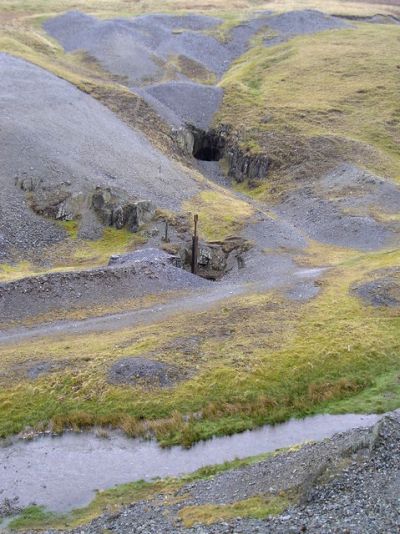
Dylife Mine – Main adit and Llechwedd Ddu shaft
Copyright © Chris Andrews
and licensed for reuse under this Creative Commons Licence
Little is known of the early history of this mine, which is 8½ miles north-west of Llanidloes on the road to Machynlleth. The principal workings were on the Dylife, Llechwedd Ddu and Esgairgaled veins, which fan out in Silurian rocks from the eastern end of a west to east fault.
Dylife vein runs west to east across the summit of Pen Dylife. It was worked by the ‘old man’, and drained by the Dylife adit, but in 1849 it was said not to have been worked for some years. The Old Engine Shaft on this vein is thought to have been pumped using a waterwheel (site unknown).
When Hugh Williams took the mine in 1818 he concentrated on the Llechwedd Ddu vein. Here, the Engine Shaft, which was pumped by a waterwheel from 1839, had reached the 45 fathom level by 1849 and was working rich ore ground to the east and west of it. Output fell sharply in 1855, as the ore dried up, but recovered after June 1856 when good ore was found at the 75 fathom level.
Hugh Williams’ daughter married Richard Cobden in 1840. He was a Manchester Liberal who, along with John Bright, earned fame for bringing about the repeal of the Corn Laws. Williams died in 1853 and, as one of his trustees, Cobden was well placed to form a company, to be managed by John Taylor & Sons, which bought the mine for £24,000 in 1858.
The mine was modernised by using cages in the winding shafts, which allowed stuff to be brought out of the mine in waggons and trammed to the dressing floors or spoil heaps without multi-handling. While becoming common in collieries, this was rare in metal mines. Instead of steam engines, however, large waterwheels were used, giving a major saving on fuel and set-up costs.
Thus, in 1861, a fifty by six foot waterwheel was built by the stream 585 metres downstream from the road leading to the Star Inn and linked to the Old Engine Shaft by a wire rope for winding. Another rope ran from the wheel to Boundary Shaft, nearly a mile away. This shaft, which reached a depth of 120 fathoms below adit, also had a 60 inch Cornish pumping engine. Llechwedd Ddu Engine Shaft and Bradford’s Shaft, which reached a depth of 130 fathoms at the eastern end of Llechwedd Ddu vein, were both fitted with cages. Both shafts were wound by ropes from the 63 foot diameter Red Wheel
By 1849 a crosscut was being driven north at the 25 fathom level cut the Esgairgaled vein, but found it so poor that it was left as being of little value. Around 1861, however, a short drive to the east in the vein from the end of the crosscut discovered rich ore. Later another oreshoot was found a short distance to the west.
With output declining the mine was sold to the Dylife Lead Mining Company for £73,000 in 1873. It spent heavily on the mine, and put a skip road in Boundary Shaft, which was sunk to the 132 fathom level. Various other trials proved unsuccessful and the company was re-floated as the Great Dylife Lead Mining Company in 1876. It fared little better, but in 1879 Alfred’s Shaft was sunk to work a 12 inch rib of galena in a vein of the same name. The ore and money ran out and the company collapsed in 1884.
The final stage of mining began in 1886 when Dylife was renamed Blaen Twymyn and worked by the Blaen Twymyn Mining Syndicate Ltd. It raised lead and some zinc from Esgairgaled vein before giving up in 1891.
Further reading:
- Bick, D. Dylife (Newent: The Pound House, 1975)
- Williams, C.J. “Cobden and Bright at Dylife” Bulletin of the Peak District Mines Historical Society, Vol.15 Nos 4/5, 2004, pp.47-49

